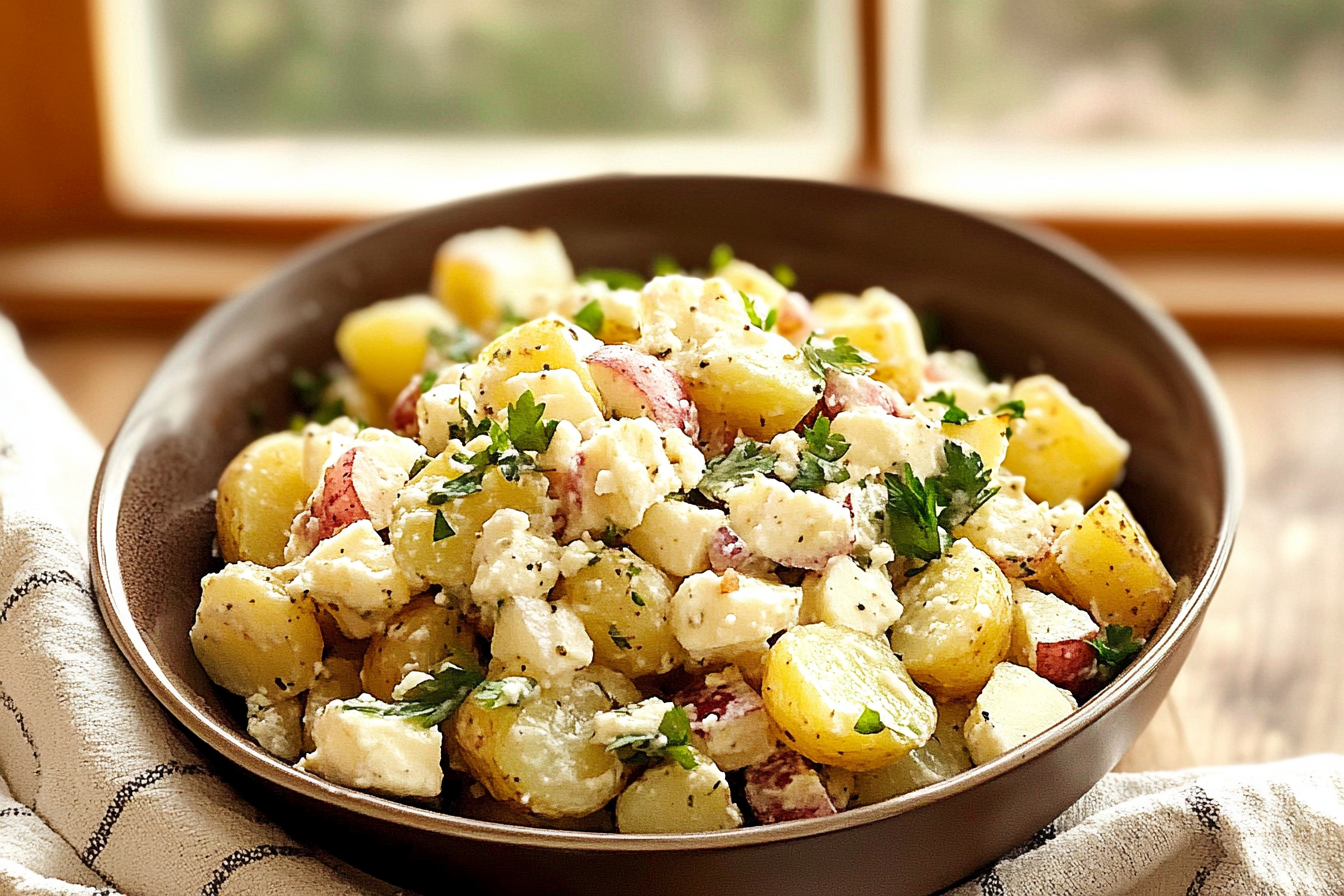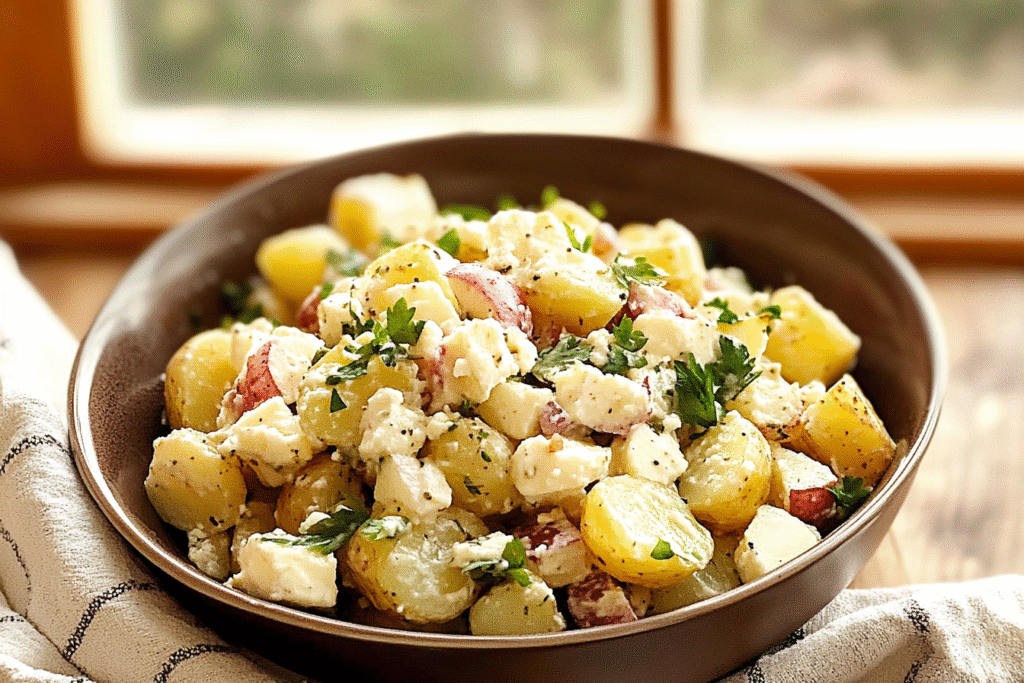
Greek Potato Salad is a fresh and flavorful alternative to traditional potato salads. Instead of using heavy mayonnaise, this version relies on a bright lemon-oregano vinaigrette and rich olive oil, capturing the essence of Mediterranean cuisine. The combination of tender boiled potatoes with crisp cucumbers, juicy tomatoes, Kalamata olives, and salty feta cheese creates a vibrant dish perfect for warm weather meals or anytime you want a lighter, healthy side.
This salad is naturally gluten-free, vegetarian, and packed with nutrients. It’s easy to prepare with simple ingredients available in most American supermarkets. Whether served alongside grilled chicken, seafood, or as a standalone lunch, Greek Potato Salad delivers satisfying textures and bold flavors.
Mediterranean diets are known for heart-healthy fats and fresh produce, and this salad fits right in. The olive oil offers good fats, while the fresh vegetables provide vitamins and antioxidants. Plus, the lemon juice adds a zesty brightness that balances the dish perfectly.
In this blog, you’ll learn how to make this classic salad from start to finish, including tips on ingredient selection, cooking the potatoes just right, and how to store leftovers. Whether you’re new to cooking or a seasoned pro, this recipe is simple yet impressive.
Why You’ll Love This Greek Potato Salad
Greek Potato Salad stands out because it combines comfort and freshness in one bowl. The potatoes offer a filling base, while the crisp veggies and tangy dressing keep it light and flavorful. Unlike traditional mayo-based salads, this recipe uses olive oil and lemon juice for a heart-healthy, vibrant taste.
Its versatility makes it a great side for many meals—grilled chicken, fish, or even vegetarian dishes. The salty feta and briny olives add depth, while fresh herbs like oregano bring that authentic Mediterranean flair. You can also customize the salad by adding bell peppers, fresh dill, or even a pinch of garlic.
This salad is not only delicious but nutritious. It provides healthy fats from olive oil, complex carbs from potatoes, and protein from feta. It’s gluten-free and easily adaptable for vegans by skipping or substituting the cheese.
Finally, this dish is a crowd-pleaser for picnics, potlucks, or family dinners. Its colorful presentation and mix of textures—from soft potatoes to crunchy veggies—make it enjoyable to eat and beautiful to serve. It’s a simple recipe that never fails to impress.
What You’ll Need
To make a flavorful and refreshing Greek Potato Salad, you’ll need simple, wholesome ingredients commonly found in U.S. grocery stores. The base of the salad is potatoes—Yukon Gold or red potatoes work best due to their creamy texture and ability to hold shape after boiling. Avoid overly starchy varieties like Russets, which tend to fall apart.
Next, you’ll need crunchy, fresh vegetables: cherry tomatoes, cucumbers, and red onions. These bring brightness, juiciness, and just a touch of sharpness. Kalamata olives are essential for that briny, authentic Greek taste. Make sure they’re pitted for easy eating.
Feta cheese, crumbled over the salad, adds salty richness. If possible, go for block feta in brine for better flavor than pre-crumbled varieties.
The dressing is simple but key: extra virgin olive oil (for richness), lemon juice (for acidity and freshness), dried oregano (for that signature Greek herb flavor), plus a bit of salt and pepper. Optional ingredients like fresh parsley or dill can add a fragrant, herbal touch.
Here’s a summarized list:
- 2 lbs Yukon Gold or red potatoes
- 1 cup cherry tomatoes, halved
- 1 cup cucumber, diced
- 1/2 small red onion, thinly sliced
- 1/2 cup Kalamata olives, halved
- 1/2 cup feta cheese, crumbled
- 1/4 cup extra virgin olive oil
- 3 tbsp lemon juice
- 1 tsp dried oregano
- Salt & black pepper, to taste
- Optional: fresh parsley or dill
These ingredients combine for a balanced, tangy, and colorful salad that’s perfect for summer meals or as a make-ahead side.
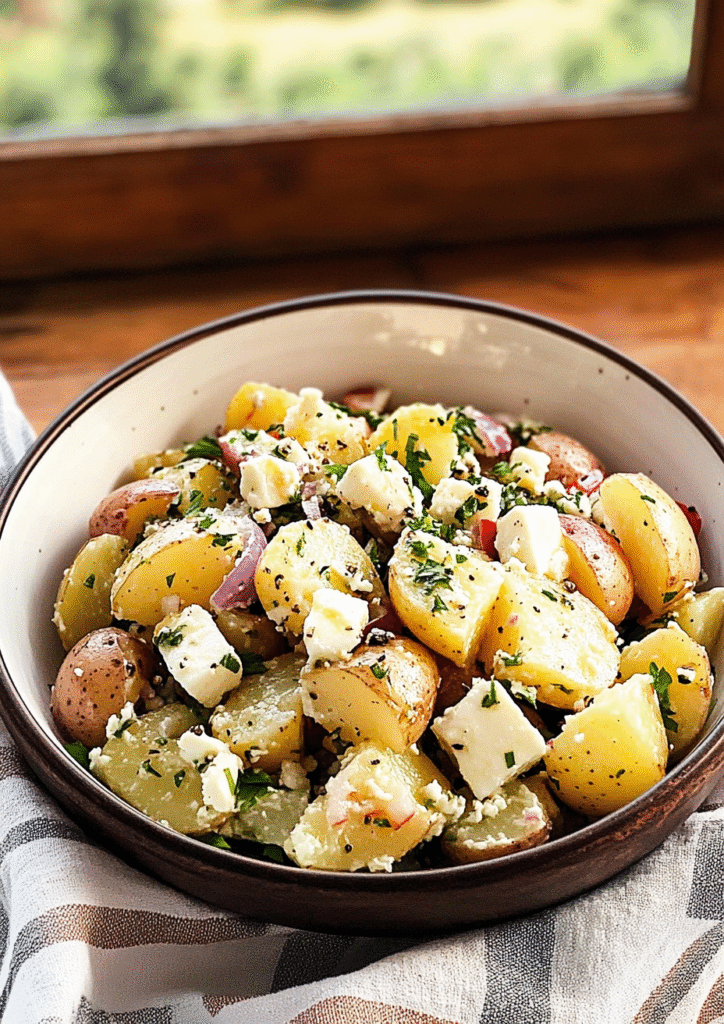
How to Make Greek Potato Salad
Greek Potato Salad comes together in just a few easy steps. The key is properly cooked potatoes, fresh produce, and a well-balanced dressing.
Step-by-Step Instructions:
- Boil the Potatoes: Add 2 lbs of chopped Yukon Gold or red potatoes to a pot of salted water. Bring to a boil, reduce to a simmer, and cook for 12–15 minutes until fork-tender. Drain and let cool slightly.
- Prep the Veggies: While the potatoes cool, slice 1 cup of cherry tomatoes, dice 1 cup of cucumber, thinly slice ½ small red onion, and halve ½ cup of Kalamata olives.
- Make the Dressing: In a bowl, whisk together ¼ cup olive oil, 3 tbsp lemon juice, 1 tsp dried oregano, salt, and pepper to taste.
- Assemble the Salad: In a large bowl, combine the potatoes, tomatoes, cucumbers, onions, and olives. Drizzle the dressing over the top and gently toss everything together.
- Finish with Feta: Add ½ cup of crumbled feta and optional herbs like parsley or dill. Lightly toss or leave the feta on top for a decorative touch.
- Serve or Chill: Enjoy immediately, or refrigerate for 30–60 minutes to let the flavors meld.
This easy recipe makes about 6 servings and pairs wonderfully with grilled meats or a light summer lunch. Adjust salt, lemon, or herbs to taste before serving.
You Must Know
Before you start making Greek Potato Salad, there are a few key things to keep in mind to get the best flavor and texture.
Choose the Right Potatoes: Yukon Gold or red potatoes are ideal. They’re waxy, hold their shape, and have a creamy texture when cooked. Avoid starchy types like Russet, which fall apart easily in salads.
Salt the Water: Always salt the boiling water. This is the first and best opportunity to infuse your potatoes with flavor. Unsalted water leads to bland potatoes, and no dressing can fully fix that later.
Cool Slightly Before Mixing: Tossing dressing onto steaming hot potatoes can turn the salad mushy. Let them cool for 5–10 minutes so they’re warm enough to absorb flavor, but not too hot to handle.
Use Fresh Ingredients: Fresh lemon juice, quality olive oil, and good feta cheese make a noticeable difference. Since the dressing is simple, every ingredient really counts.
Mind the Salt Levels: Feta and Kalamata olives already bring salty, briny flavor. Taste before adding more salt to avoid over-seasoning.
Let It Rest: Greek Potato Salad tastes better after resting in the fridge for 30 minutes. The flavors come together, and the dressing soaks into the potatoes more evenly.
Keep It Simple: It’s tempting to overload this salad, but its charm lies in balance. If you want to customize, add just one or two extras—like bell peppers, fresh dill, or even a sprinkle of capers.
By keeping these points in mind, you’ll avoid common pitfalls and make a salad that’s fresh, vibrant, and restaurant-quality every time.
Perfecting the Cooking Process
Getting the cooking process right is the secret to a perfect Greek Potato Salad. It all starts with the potatoes.
Cut Evenly: Chop potatoes into even, bite-sized pieces so they cook at the same rate. Uneven sizes mean some pieces will be mushy while others are undercooked.
Start in Cold Water: Place potatoes in cold, salted water and bring to a boil. This ensures they cook evenly from the inside out. Boiling water from the start often results in hard centers and overcooked outsides.
Simmer, Don’t Boil Hard: Keep the heat at a gentle simmer for 12–15 minutes. Check with a fork—they should be tender but not falling apart.
Drain and Let Them Steam: After draining, let potatoes sit uncovered for a few minutes to release extra moisture. This makes them absorb dressing better and keeps the salad from getting watery.
Add Dressing While Warm: Warm potatoes absorb more flavor. Add your lemon-olive oil vinaigrette while the potatoes are still slightly warm—but not hot—to let the flavors soak in.
Toss Gently: Use a soft spatula or spoon to combine the ingredients. Don’t stir too aggressively or you’ll crush the potatoes and lose that nice chunky texture.
Hold the Feta for Last: Add feta cheese right before serving so it stays intact and visually appealing. The same goes for fresh herbs—they’ll wilt less and keep their flavor stronger.
Cooking potatoes properly is the single biggest step to getting this recipe right. When done well, the final dish will be flavorful, fresh, and beautifully textured—everything you want in a Mediterranean-style salad.
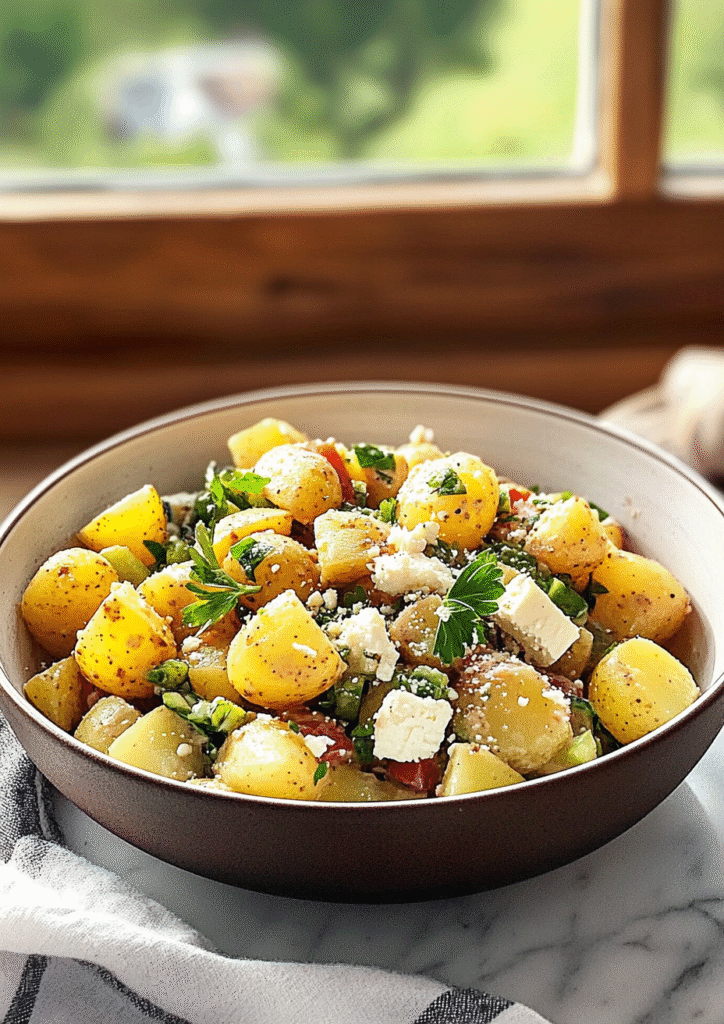
Add Your Touch Greek Potato Salad
Greek Potato Salad is easy to customize, making it perfect for any occasion. The base is delicious as-is, but you can easily adapt it to suit your taste or what you have on hand.
Change Up the Veggies: Add color and crunch with bell peppers, green beans, or shredded carrots. These extras pair well with the lemony dressing and add more nutrition.
Make It a Meal: Turn your salad into a full lunch or light dinner by adding grilled chicken, canned chickpeas, or hard-boiled eggs. These protein boosts are filling and blend beautifully with the Mediterranean flavors.
Go Vegan: Just leave out the feta or use a plant-based alternative. The salad still delivers plenty of bold, briny flavor from the olives and lemon dressing.
Play with Herbs: Traditional oregano is great, but fresh parsley, dill, or mint add brightness. Dill is especially nice with cucumber and gives the salad a fresh garden taste.
Add Garlic or Crunch: Minced garlic in the dressing adds depth, while a handful of sunflower seeds or toasted pine nuts on top brings crunch—great if you’re skipping the cheese.
Try Roasted Potatoes: Instead of boiling, roast the potatoes for extra flavor. Toss with olive oil, salt, and pepper, and roast at 400°F for 25–30 minutes. Let them cool slightly before mixing with the rest of the salad.
This is a recipe you can keep classic or get creative with. Just don’t overload it—the best Greek Potato Salad is still fresh, simple, and balanced.
Storing & Reheating
Greek Potato Salad stores well and can even taste better the next day. But keeping it fresh comes down to proper storage and small tricks to revive it.
Refrigerate Properly: Store in an airtight container for up to 3–4 days. The flavors continue to develop, so leftovers are delicious.
Your taste buds will thank you for this one.
Prevent Sogginess: Let potatoes cool before mixing and avoid adding juicy veggies like tomatoes too early if you plan to store it. You can mix those in just before serving.
Add Feta Later (Optional): If you’re prepping ahead, wait to add the feta and herbs until serving. This keeps them from getting soft or losing flavor.
Refresh Before Serving: A quick drizzle of olive oil and splash of lemon juice before eating makes the salad taste fresh again.
Reheat Gently (If Needed): It’s usually served cold or room temp, but if you want it warm, heat gently in a skillet. Skip the microwave—it can ruin the texture.
Freezing? Not a Good Idea: The texture of potatoes and fresh vegetables doesn’t hold up well after freezing, so enjoy it fresh from the fridge.
With proper storage, this salad is great for meal prep, parties, or weekday lunches.
Chef’s Helpful Tips for Greek Potato Salad
Making Greek Potato Salad is simple, but these expert tips can help you take it from good to great every single time.
1. Use Waxy Potatoes: Yukon Gold or red potatoes are ideal because they hold their shape well and have a creamy texture. They won’t fall apart when mixed with dressing.
Check out this must-make side dish.
2. Don’t Overcook: Boil the potatoes just until fork-tender. Overcooked potatoes can become mushy and ruin the salad’s texture. Simmer gently and test often.
3. Season the Water: Always salt the water when boiling potatoes. It’s the only time you can season them from the inside. This one step makes a huge difference in flavor.
4. Let Potatoes Steam Dry: After draining, spread them out and let them steam for a few minutes. This removes excess water, so they absorb more dressing and don’t get soggy.
5. Toss with Dressing While Warm: Warm (not hot) potatoes soak up flavor best. Add the lemon-olive oil dressing when they’ve cooled just slightly for the most delicious results.
6. Don’t Overdress: Start with a smaller amount of dressing, then add more if needed. This helps you avoid a greasy or overly wet salad.
7. Add Feta Last: Mix in feta gently at the end to keep its texture intact. You want soft crumbles, not mush.
8. Use Fresh Lemon Juice: Bottled lemon juice just doesn’t compare. Fresh juice brightens the entire dish and gives the salad that signature Greek zing.
9. Chill Before Serving: Letting the salad rest in the fridge for 30–60 minutes helps all the flavors come together beautifully.
10. Taste and Adjust: Before serving, always taste and tweak. A little extra lemon, salt, or pepper can elevate everything.
With these tips, your Greek Potato Salad will have the perfect balance of flavor, freshness, and texture—every time.
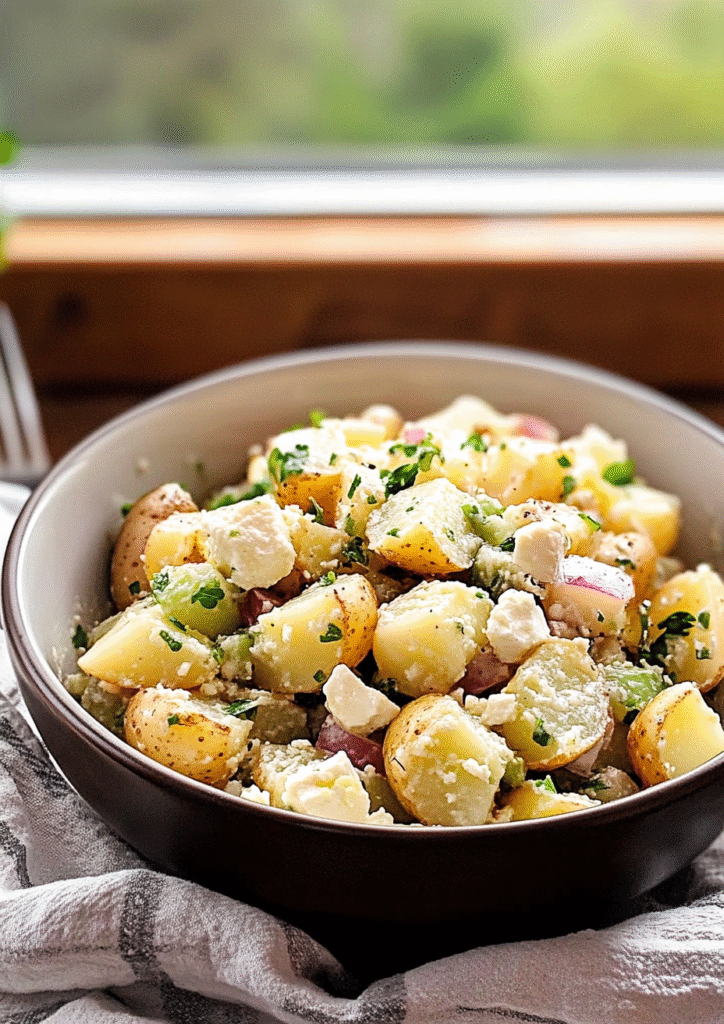
FAQ for Greek Potato Salad
Can I make this ahead of time?
Yes! Greek Potato Salad is great for making ahead. In fact, the flavors develop more as it chills. Just wait to add feta and herbs until just before serving for the best texture.
How long does it last in the fridge?
Stored in an airtight container, it keeps well for 3–4 days. Refresh with a drizzle of olive oil and lemon juice if needed.
Here’s a cozy dish that’s always a hit.
Can I use other potatoes?
You can, but avoid Russet or baking potatoes—they’re too starchy and fall apart. Stick with waxy varieties like red or Yukon Gold.
Is this salad served warm or cold?
Traditionally, it’s served cold or at room temperature. However, you can enjoy it slightly warm if preferred—just don’t overheat it or the feta will melt.
Can I skip the olives or feta?
Absolutely. If you’re not a fan of olives or are avoiding dairy, feel free to omit them. The salad still tastes fresh and flavorful.
Can I double the recipe for a party?
Yes! Just double all ingredients and prep in a large bowl. It’s a great side for potlucks, cookouts, or family gatherings.
Is it gluten-free?
Yes, this recipe is naturally gluten-free. Just ensure any added ingredients like store-bought feta or seasoning mixes are labeled gluten-free if needed.
What protein can I add?
Try grilled chicken, shrimp, or chickpeas. These blend well with the Mediterranean flavors and make it a satisfying meal.
This Greek Potato Salad is flexible, reliable, and perfect for just about any occasion.
Conclusion
Greek Potato Salad is a refreshing, flavorful twist on a classic side dish that brings together the best of Mediterranean cooking—fresh vegetables, tender potatoes, bold herbs, and a zesty lemon-olive oil dressing. It’s a healthier, lighter alternative to heavy mayo-based potato salads and makes a perfect addition to picnics, potlucks, or even weeknight dinners.
What makes this salad stand out is its versatility. You can serve it warm, cold, or room temperature. It pairs well with grilled meats, seafood, and vegetarian mains, and it can even stand alone as a light lunch. You can also easily adapt it—swap herbs, toss in more veggies, or keep it dairy-free and vegan.
Beyond its flavor, Greek Potato Salad fits effortlessly into a balanced lifestyle. It’s naturally gluten-free, packed with wholesome ingredients, and easy to prep ahead. It gets better after sitting, stores well, and is always a crowd-pleaser.
Whether you’re new to Mediterranean-style dishes or just looking to upgrade your side salad game, this recipe is a must-try. It’s simple, satisfying, and full of bright, fresh flavors that will leave everyone reaching for seconds.
Now that you know the secrets—from choosing the right potatoes to building in your own personal touches—it’s time to give it a try. With just a few basic ingredients and easy steps, you can create a dish that’s both impressive and delicious.
So go ahead—grab those fresh veggies, whip up that lemony dressing, and enjoy a big bowl of homemade Greek Potato Salad. Once you do, it’ll quickly earn a spot in your regular recipe rotation.

The Best Greek Potato Salad Recipe: Fresh, Easy & Flavorful
Description
A refreshing, mayo-free potato salad bursting with Mediterranean flavors! Packed with olive oil, lemon juice, herbs, and crunchy vegetables, this side dish is perfect for picnics, BBQs, or light lunches.
Ingredients
Instructions
Boil potatoes in salted water for 12–15 minutes until fork-tender. Drain and let cool slightly.
In a small bowl, whisk olive oil, lemon juice, mustard, garlic, salt, and pepper.
In a large bowl, combine potatoes, red onion, tomatoes, cucumber, olives, and parsley.
Drizzle dressing over the salad and toss gently to coat.
Top with crumbled feta and chill before serving if desired.
Notes
- For extra flavor, add a pinch of oregano or dill.
This salad is best served slightly warm or at room temperature.
Make it ahead—flavors improve after a few hours in the fridge!

